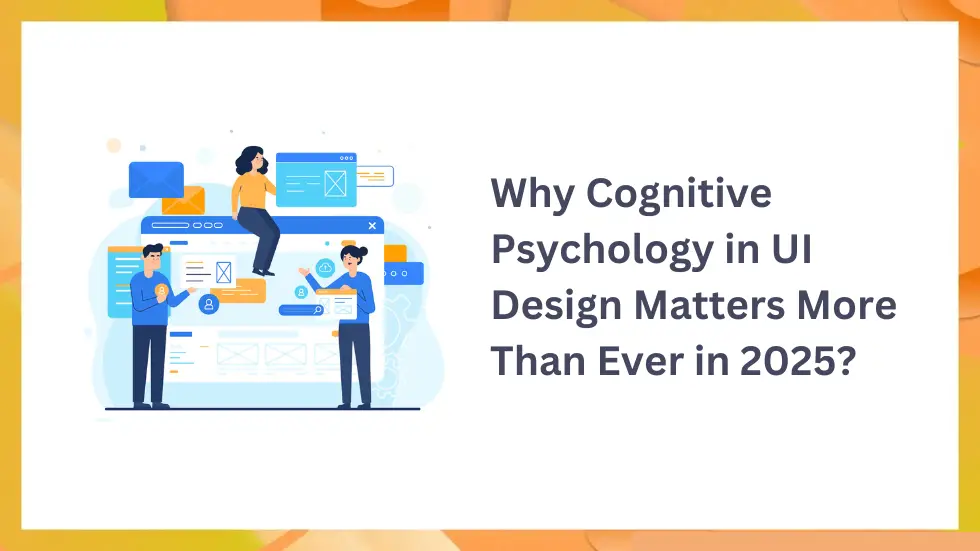In 2025, creating successful digital products requires more than just sleek visuals. With users interacting across multiple platforms, bombarded by constant choices and stimuli, cognitive psychology in UI design has become a strategic necessity.
It’s about designing interfaces that not only look good but also align with how people actually think, behave, and decide.
Two classic psychological principles—Fitts’s Law and Hick’s Law—remain essential tools in the designer’s toolkit. When thoughtfully applied, they help reduce friction, minimize cognitive load, and guide user behavior across web and mobile interfaces.
This blog explores how to apply cognitive psychology in UI design using these laws, enhanced with modern techniques like AI personalization, adaptive interfaces, and inclusive UX practices.
🔍 Understanding the Core Principles of Cognitive Psychology in UI Design
✅ Fitts’s Law (1954)
Fitts’s Law predicts that the time it takes to interact with an object (like a button or link) depends on the distance to the object and its size.
Key takeaway: The closer and larger a UI element is, the quicker users can interact with it.
✅ Hick’s Law (1952)
Hick’s Law suggests that decision-making time increases as the number of choices grows.
Key takeaway: Too many options slow users down and increase the chance of drop-off or confusion.
By applying these psychological principles in interface design, you can reduce user fatigue and help them complete tasks faster—leading to improved engagement and conversion rates.
💡 Real-World Applications of Psychology in Modern UI/UX
1. AI-Personalization + Hick’s Law = Smarter Decisions
AI-powered platforms (like Amazon, Netflix, or Spotify) leverage user behavior in interface design to reduce decision fatigue. Hick’s Law supports this by showing that fewer, context-relevant options lead to better outcomes.
💡 Design Tip:
Use progressive disclosure—display only key actions first, then reveal more as needed.
2. Touch-Friendly UI with Fitts’s Law in Mind
With mobile and wearable use continuing to dominate, touch targets must align with Fitts’s Law. Poorly sized or closely spaced elements frustrate users—especially those with motor or visual challenges.
💡 Design Tip:
Maintain a minimum touch target of 44px and use padding to make high-priority actions easy to access.
♿ Inclusive UX: Psychology Supporting Accessibility
Cognitive psychology in UI design is essential to building accessible and inclusive digital experiences:
- Users with tremors or mobility challenges benefit from larger, well-spaced elements (Fitts’s Law).
- Neurodivergent users or those with ADHD benefit from limited options per screen to reduce cognitive load (Hick’s Law).
💡 Design Tip:
Incorporate focus indicators, clear visual cues, and predictable navigation to support all users.
🛠️ Tools and Techniques to Put Psychology into Practice
Modern tools can help bridge cognitive theory and UI execution:
- Figma AI: Evaluate spacing, hit area size, and interaction friction.
- Able Plugin: Perform accessibility audits in real time.
- Hotjar / FullStory: Use heatmaps and behavior tracking to analyze how users interact with elements.
Workflow Tip:
- Use session recordings to detect hesitation (Hick’s Law).
- Use click data to identify hard-to-reach areas (Fitts’s Law).
🤝 Why Cross-Functional Teams Should Understand These Laws
When product managers, designers, and developers share an understanding of cognitive psychology in UI design, product development becomes more user-centric and aligned with business goals.
Examples of Collaborative Benefits:
- Reduced clutter in navigation menus
- Larger hit areas for mobile apps
- Simplified user journeys during onboarding
💡 Tip:
Include psychological guidelines in design system documentation to guide consistent decision-making across teams.
📈 Business Impact of Applying UI Psychology
Good UX design informed by psychology translates to business results. Ignoring cognitive load in UI/UX often leads to:
- High bounce rates
- Low task completion
- Increased user frustration
📊 Studies show a 10% reduction in cognitive load can increase conversion by up to 30%, especially in onboarding and e-commerce flows.
🚀 Looking Ahead: Psychology + AI + Inclusive Design
In 2025, cognitive psychology in UI design will merge even further with emerging trends like:
- Context-aware interfaces
- Microinteractions
- AI-generated layouts
- Real-time UX adaptation
The goal? To create frictionless, inclusive, and decision-friendly experiences that feel tailored to the user.
✨ Conclusion: Design With the Brain in Mind
Fitts’s and Hick’s Laws are more than academic concepts—they’re the foundation of user-centered, psychologically sound interfaces.
By understanding how humans process decisions and interact with systems, startups and enterprises can:
- Improve usability
- Increase retention
- Build trust and loyalty
Incorporating cognitive psychology in UI design is no longer optional. It’s how digital products win users’ time, trust, and business in 2025.
Additional Resources:
